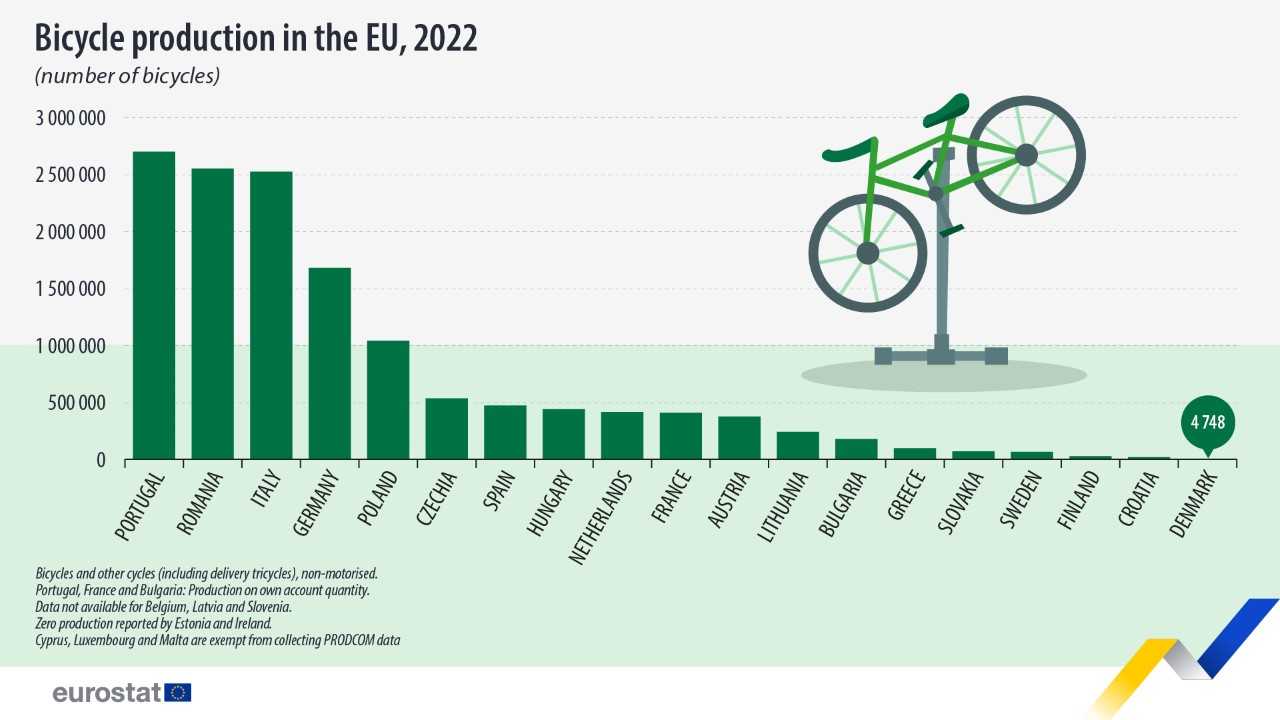The bicycle aftermarket is a significant and growing part of the global bicycle industry. It refers to the market for bicycle-related products and services that are purchased and used after the initial purchase of a bicycle. This market is driven by a combination of factors, including the increasing popularity of cycling, the availability of high-quality and specialized products and services, and the desire of consumers to customize and improve their bicycles.

Credit: Eurostat
The diagram detailing bicycle production in the European Union for 2022 highlights Portugal as the leading producer with over 2.7 million bicycles manufactured, followed closely by Romania and Italy, each producing approximately 2.6 million bicycles. Germany ranks fourth with a significant drop to about 1.5 million units. Poland and Czechia follow with around 1 million and 600,000 units, respectively. Other notable producers include Spain, Hungary, the Netherlands, France, and Austria, each contributing between 300,000 and 500,000 bicycles. The chart also notes lower production figures for countries like Lithuania, Bulgaria, Greece, Slovakia, Sweden, Finland, Croatia, and Denmark, with Denmark producing the fewest at under 5,000 bicycles. This visualization underscores the concentration of bicycle manufacturing in a few key countries within the EU, with a steep decline in production numbers as the list progresses.
Cycling enthusiasts around the world know that the journey doesn’t end with the purchase of a bicycle. In fact, it often marks the beginning of an exciting exploration into the vast world of bicycle aftermarket parts and accessories. This thriving sector offers cyclists myriad options to customize, enhance, and maintain their bikes, ensuring an optimal riding experience tailored to individual preferences and needs.
One of the primary attractions of the bicycle aftermarket is the ability to upgrade and personalize. For many, the stock components that come with a new bike are just a starting point. The aftermarket provides high-quality alternatives and upgrades for virtually every part of the bicycle. From lightweight carbon fiber frames and aerodynamic wheelsets to precision-engineered drivetrains and ergonomic saddles, the options are endless. Cyclists can replace basic components with premium parts that enhance performance, reduce weight, and improve comfort.
Performance upgrades are particularly popular among competitive cyclists and avid hobbyists alike. Swapping out a standard crankset for one with a higher gear ratio can make a significant difference in speed and efficiency. Similarly, investing in a top-tier braking system can provide better control and stopping power, essential for safety on both city streets and mountain trails. Even something as seemingly minor as high-quality tires can drastically change the riding experience by offering better grip and lower rolling resistance.
Comfort is another crucial aspect that the bicycle aftermarket addresses. A poorly fitting saddle or handlebar can turn a pleasant ride into an ordeal. Aftermarket saddles come in various shapes, sizes, and materials to suit different body types and riding styles. Likewise, handlebars can be replaced with options that offer better ergonomics, reducing strain on the wrists and shoulders. Suspension seatposts and handlebar grips with specialized padding further enhance comfort, making long rides more enjoyable.
The rise of electronic and smart accessories has also revolutionized the bicycle aftermarket. Cyclists can now equip their bikes with GPS units, power meters, and smart lights that adjust their brightness based on ambient conditions. These innovations not only enhance performance but also add a layer of safety and convenience. For instance, smart helmets with integrated communication systems allow riders to stay connected without compromising their focus on the road.
Maintenance and repair are essential aspects of bike ownership, and the aftermarket caters to these needs with a wide range of tools and replacement parts. Home mechanics can find everything from basic multi-tools to advanced repair stands and diagnostic devices. Regular maintenance ensures that a bike remains in top condition, extending its lifespan and maintaining peak performance. Additionally, readily available replacement parts mean that cyclists can quickly address wear and tear without having to replace the entire bike.
The aesthetic appeal of bicycles also finds ample expression in the aftermarket. Custom paint jobs, decals, and colorful accessories allow cyclists to express their personality and style. Whether it’s a sleek, minimalist look or a vibrant, eye-catching design, the aftermarket provides the tools and parts to transform a bike into a unique work of art.
Sustainability is another driving force behind the popularity of the bicycle aftermarket. Instead of discarding old or worn-out bikes, cyclists can refurbish and upgrade them, reducing waste and promoting a more sustainable approach to cycling. Many aftermarket companies are also focusing on environmentally friendly materials and processes, further aligning the cycling community with green initiatives.
The bicycle aftermarket is a dynamic and ever-evolving industry that enriches the cycling experience. It empowers cyclists to tailor their bikes to their specific needs and preferences, enhances performance and comfort, and supports sustainable practices. As cycling continues to grow in popularity as a means of transportation, exercise, and recreation, the aftermarket will undoubtedly play a crucial role in shaping the future of this beloved activity.